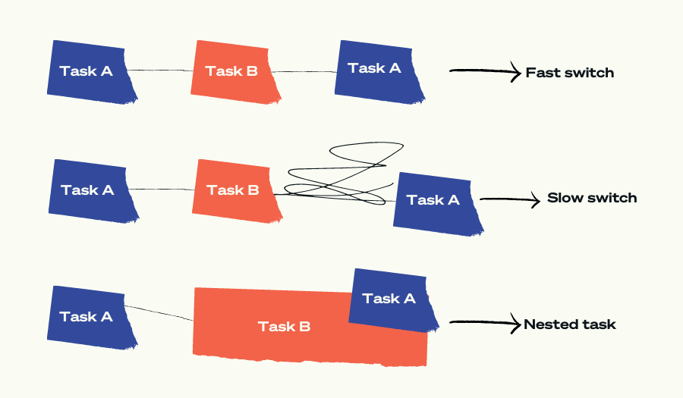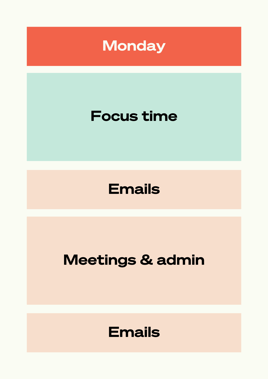
Beat distractions with focus time
Tried and tested tips and tricks for focus time from a self-professed productivity nerd (our COO).
Have you ever reached the end of a busy day and felt like you haven’t achieved anything? Distraction is a huge killer of productivity, so let’s chat about some of the reasons why it happens, how you can reduce it and what focus time did for our team.
I’m a productivity nerd. I love looking at the things we do and understanding how some of them slow us down. I’m also a believer in productivity for purpose. My goal with productivity at work is not to create 20% more widgets but to create space to allow for creativity and enjoyment.
Firstly, allow this productivity nerd to clear something up...
Multitasking is a lie
We can’t actually do two things at once. What we really do when we think we’re multitasking is task switching.
Let's look at three different types of task switches.
Fast Switch
Imagine you’re working away on a project and a Slack (or Teams) notification pops up.
Jeff: Hey
Your brain jumps into action. It’s Jeff from Finance. What could Jeff want? We spoke last week about changing my super plan. That isn’t important right now, back to this document… where was I again?
This all happens in 1/10th of a second so you think that it didn’t cost you anything but that thought “where was I again” is a telling sign. In this case, it was a fast switch – you were working on something, glanced up and then went back to the task.
But often the path isn’t as quick.
Slow Switch
Sometimes the messages aren’t as easy as Jeff’s to dismiss – like a message from your manager.
Jessica: Hey, can you help me with the presentation next week?
Your brain jumps into action again.
- I hope she doesn’t want me to speak in front of everyone
- I don’t like speaking
- Urgh now I’m worried about speaking
- I’ll just message her back now

Turns out she just needed some numbers to include in the presentation. But now that message from Jeff is back on your radar… so you think about your super plan a bit more… <20mins later> now where was I again?
In a slow switch, you might not go back to the original task for 20+ mins – or ever at all.
Nested Tasks
You end up with nested tasks when you switch tasks but can’t let go of the new information when you return to your original task.
Let’s say you did a slow switch and got some bad news. Jan reviewed your work and she really pulled it apart. Worse, it’s not even constructive feedback, she was just being hyper-critical (and cc’ed everyone, thanks Jan).
You know you have to get your original task done before lunch, so you close the email and try to refocus... but you can’t. You can’t stop thinking about Jan and her email but you need to get your report done… now where was I again?
Nested tasks increase stress and cognitive load – they’re a long way from focus.

Here are some interesting stats:
- One study found that the average time to resume a task once distracted was 23 minutes
- Another study found it can take up to 18 minutes to get to the same level of focus when returning to a previous task.
- Yet another study found that once distracted, 41% of the time you never resume the original task.
Making it all better
There is a solution for all of these distractions and that is to create focus time for your deep work.
Deep work includes things like your big projects, writing a blog, being creative, or getting that TPS report out. Deep work is heavy thinking work that requires your undivided attention.
Then use your unfocused time for meetings, admin, emails or anything that feels like shrapnel.
An ideal day might look like this:

What your ideal day looks like will depend very much on you, your role and company. If you’re customer-facing you might spend more time on email or if you’re working on complex projects you might need more time to focus. Every day might not look the same and every role has different needs.
For me, morning focus time means getting a couple of big tasks off my to-do list, then the entire afternoon I can bounce between meetings, fight fires, respond to random questions and at the end of the day still feel like I've achieved some productive work.
Putting it in place
You might look at this and think: a morning without emails? Tell him he’s dreaming! So here are some tips to set yourself up:
- Focus time only really works if your whole team or company are on board with you (or everyone) working this way. It’s possible but a lot harder if you are a lone wolf, so start a discussion.
- Book out your focus time in your calendar and let everyone know you are doing it.
- It doesn’t have to be perfect on day one. If you have recurring meetings, move what you can over time and accept what can't be moved.
- Your immediate calendar is typically chaos, so don’t start next week. Start by looking at your calendar in a month's time and work from there.
Making it work
- Protect your focus time from random meetings. It’s easy to think that you can book meetings in your focus time, but what it really means is that you’re robbing yourself of the time that you need to do your best productive work.
- Defend your focus time from internal disruption. Five minutes to chat is potentially 30 minutes of lost focus time. It’s not just the chat but the time it takes you to get back to a deep work state.
- When adding extra activities into focus time, think of what that will do to your deliverables for the week and if it’s worth it. Sometimes it is, only you can decide.
- Turn off your notifications during focus time. Tools like Slack have a ‘do not disturb' feature that mutes your notifications but gives someone the ability to push through that if it’s an emergency.
Our results
Since we started to recommend focus time at the Crowd, 66.6% of the team have made it a regular part of their week. Interestingly (perhaps not surprisingly), 66.6% of us also feel more productive and less stressed.
The first step is often the hardest, so start small. Book in just one block of focus time and see what you can achieve.
Great, you're on your way... now where was I again?
In addition to being our resident productivity nerd, Lee Booy is also our COO. You can learn more about Lee and the rest of your Crowd right here.
